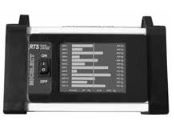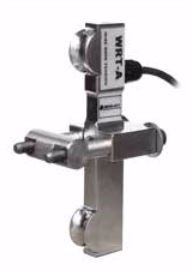Wrong tension of ropes
- Causes
- Overloading or car w.r.t. rope – rope not strong / less winding
- Rope socket slanted / hitting
- Wrongly positioned wedge rope socket clip – slipping due to faulty installation, wear and tear with age, careless maintenance
- Rope wedge is of wrong size – poor make/ careless replacement
- Diagnostic/testing method
The condition, type, number and diameter of the hoisting ropes shall be inspected while cut off the power. With power on, the hoisting ropes shall be inspected for visual defects. Spring balance or other suitable equipment shall be used to ensure the governor ropes are properly and equally tensioned (SS550).
Electronic rope tension measuring device is the most accurate and easiest instrument used to measure ropes tension. It also can adjust the ropes tension. Besides, techniques such as tuning/plucking or a torque wrench also shall be used to determine rope tension.

Control unit for rope tensioning system (RTS) [29]

Heavy duty RTS for higher-capacity elevators with larger hoist ropes [29]
- Good practices
The tension of new ropes shall be inspected and adjusted at semi-monthly intervals or over a period not less than two months after installation.
If the ropes failed to show proper equalisation of rope tension after six months, the entire set of hoist ropes shall be replaced (ASME A17.6-2010)
- Corrections
Equal tension of ropes need to be maintained to avoid differential wear of sheave grooves and ropes which will provide maximum rope service life.
Ropes are considered to be equally tensioned when the smallest tension measured is within 10% of the highest tension measured.